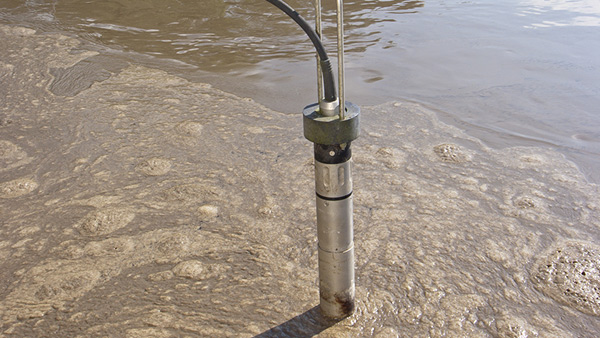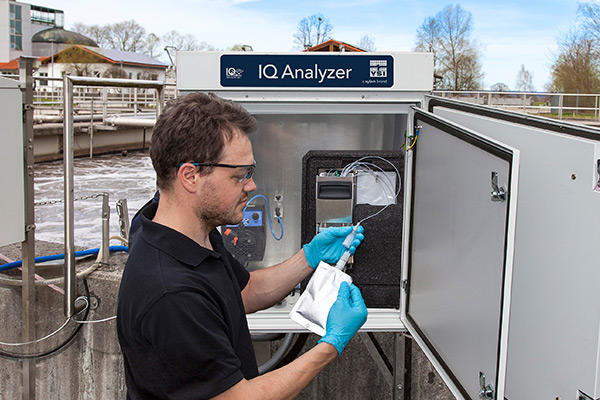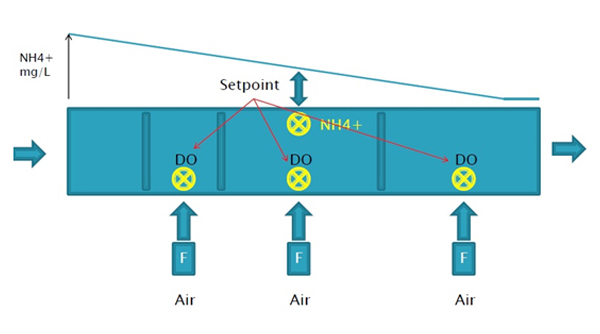ISE Sensor vs Wet Chemistry Analyzer for Ammonia/Ammonium. Which is Best for Your Application?
(Updated November 2021)
Water resource recovery facilities (WRRF) are faced with several challenges when selecting online instrumentation. Choosing the correct application, sensor location, mounting options, and understanding maintenance requirements are crucial for successful online water quality monitoring and process control.
In ammonia-based aeration control (ABAC), accurate, reliable data from ammonium analyzers or sensors are essential to monitoring and controlling aeration. One common mistake made in the sensor selection process is choosing the wrong sensor technology for an application. There are often multiple technologies for measuring a parameter, and each is often better suited for specific applications.
For example, ammonium has two online measuring technologies to choose from, and it is not always easy to decide which is best for your application. This blog discusses online ammonium measurements, the technologies available, and recommendations on when to use each type.
ISE Sensor vs Wet Chemistry Analyzer
Online ammonium measurement technology can be divided into two types: the ion-selective electrode sensor (ISE) and the wet chemistry analyzer. Although both have their place in wastewater monitoring, they are two very different technologies.
Let's first discuss the more common form, the ISE sensor. ISE sensors utilize two electrodes that create an electrochemical signal (mV). One electrode contains a selective membrane for only ammonium ions, and the other outputs a stable reference signal. The difference between the potentials, or millivolts, coming from each electrode creates a differential mV signal that increases or decreases based on the amount of ammonium in the water. The electrodes' mV signal is continuously converted into an ammonium (mg/L-NH4-N) concentration using the Nernst equation and reference samples for calibration. To maintain the sensor's accuracy, the differential signal must be routinely calibrated to the concentration of ammonium via reference samples.
Ammonium ISE sensors are popular in wastewater for the enormous benefits they can bring to the treatment process at an affordable price. With continuous ammonium measurements, automatic control of aeration can be immediate and proportional to the incoming ammonium load. This strategy allows facilities to be as efficient as possible with aeration, lowering energy costs with a minimal investment in an ISE sensor and controller. These sensors can be immersed directly in the process from a railing, which makes installation and maintenance convenient. ISE sensors require some maintenance with occasional manual cleanings, calibration via reference sample (matrix adjustment), and electrode replacement.

Each procedure can be done quickly and easily in the field. Ammonium ISE sensors have a wide measurement range with accurate, stable readings up to 1000 mg/L when maintained correctly; however, the disadvantage of an ammonium ISE sensor is at low concentrations. When concentrations are consistently near zero (below 0.5 mg/L NH4-N), the sensor will have difficulty calibrating to a reference sample and will drift faster. Also, at these lower concentrations, the effects of interfering ions will significantly impact an ISE measurement.
For example, potassium has similar properties to ammonium ions and will pass through the membrane, causing a positive interference. At low ammonium levels, this impact is substantial. YSI's online ammonium ISE sensors are unique in that they automatically compensate for potassium by using an additional potassium electrode in the sensor, providing a more accurate measurement than a non-compensating ISE.
In comparison, an online ammonium wet chemistry analyzer provides stable, automated colorimetric analysis of wastewater samples. Ammonium analyzers typically use the Berthelot /Indophenol (blue) method, which converts ammonia into blue-colored indophenol ions using reagents. The blue coloration produced is proportional to the amount of ammonium in the sample, and a spectrophotometer within the analyzer measures this color via absorbance. The Berthelot method is less susceptible to interferences meaning even more stability at low concentrations compared to ISE technology.
Online analyzers with automatic calibration and automatic cleaning functions, like the YSI Alyza, help provide accurate, stable readings, even at low concentrations. Short-term maintenance requirements for online ammonium analyzers can be minimal if the analyzer has these functions. Automatic cleaning and calibration mean the unit will rarely need attention, aside from the occasional cleaning of a filter. Maintenance requirements of filtration systems are highly dependent on the application and the type of filter used, which will vary from each manufacturer. All online ammonium analyzers require more long-term maintenance than ISE sensors, such as reagent replacement, filter exchanges, and replacement of components. The Alyza-NH4 is more hands-off than most analyzer models with reagent replacement every three months at 10-minute measuring intervals. (Learn more with this video, Alyza IQ Overview).

In comparison to ISE sensors, wet chemistry analyzers do have some disadvantages. Most importantly, online analyzers often have more specific installation requirements. Due to their large size, sufficient railing or wall space must be available for mounting, which may be difficult in wastewater facilities. Additionally, with more stringent temperature requirements, wet chemistry analyzers are best mounted in a temperature-controlled environment, such as within a building. The analyzer must also be within a certain distance (usually within 20 m) from a sample access point to pump the sample to the analyzer. Finally, wet chemistry analyzers often have a higher cost compared to ISE sensors, contributing to why ISEs are used more often.
The most common mistake made by facilities that want to measure ammonium is utilizing an ISE sensor at consistently low concentrations, below 0.5 mg/L NH4-N. Many wastewater facilities reduce their ammonium levels to near zero by ending their activated sludge processes (ASP) with an aerobic zone. The end of the ASP is a popular location to use an ISE sensor to ensure ammonium is low at the effluent or as a feedback signal for ammonia-based aeration control. With the calibration and stability issues associated with ISEs at low concentrations, the sensor may not recognize spikes in ammonium when they occur.
One possible adjustment would be not to remove all the ammonium in the ASP and to control aeration at a set point of 1 mg/L NH4-N at the end of the basins, allowing further cost savings on aeration and a suitable environment for the ISE sensor.
The other option would be to move the ammonium ISE further upstream in the ASP, where consistent ammonium concentrations are above 1 mg/L (see Figure 1). An ammonium set point upstream can still ensure ammonium levels are low by the end of the basins using waterfall logic. Also, the sensor can more effectively control aeration, will be easier to calibrate to a reference sample, have a more stable reading, and provide more useful data at these locations.

Figure 1: Aeration controlled by ammonium set points in the middle of an activated sludge basin can provide better energy savings and higher quality data from an ISE sensor (Source: Owsenek, B., Energy Savings Using Ammonia- Based Aeration Control at a 54-mgd Water Reclamation Facility, Virginia WEA 2013 Annual Conference).
Using a wet chemistry ammonium analyzer can be more effective than an ISE sensor at the end of aeration basins in low concentrations. Higher stability at low levels means the analyzer will react to occasional spikes of ammonium. The downside of an analyzer could be the measurement cycle time of the system; a cycle time of 10 minutes can still control aeration but does not react as quickly as an ISE sensor.
One of the best applications for an online wet-chemistry ammonium analyzer would be compliance assurance at the wastewater facility's effluent. Wastewater effluent typically has a low ammonium concentration, meaning an ISE sensor could be challenging to operate. However, an Alyza-NH4 at the effluent of a facility would provide accurate ammonium readings down to 0.02 mg/L NH4-N. The low solids content would also make the filtration system easy to maintain.
Between the IQ SensorNet ISE sensor and the Alyza-NH4, YSI provides the highest quality online instrumentation for ammonium measurement for wastewater facilities. The AmmoLyt delivers the most durable online ammonium ISE sensor with an electrode life expectancy of 18 months. The AmmoLyt's electrodes are individually replaceable and have mesh-covered membranes for protection during cleaning. The Alyza-NH4 provides advanced onboard diagnostics and a multi-port valve system, which reduces tubing and overall reagent use. When your application requires continuous measurement for process control or accuracy in low concentrations, YSI has you covered.

Additional Blog Posts of Interest
Top 5 Questions When Selecting UV or UV Vis Sensors
How to Control Denitrification Using Online Sensors
How to Control Activated Sludge with Online Sensors